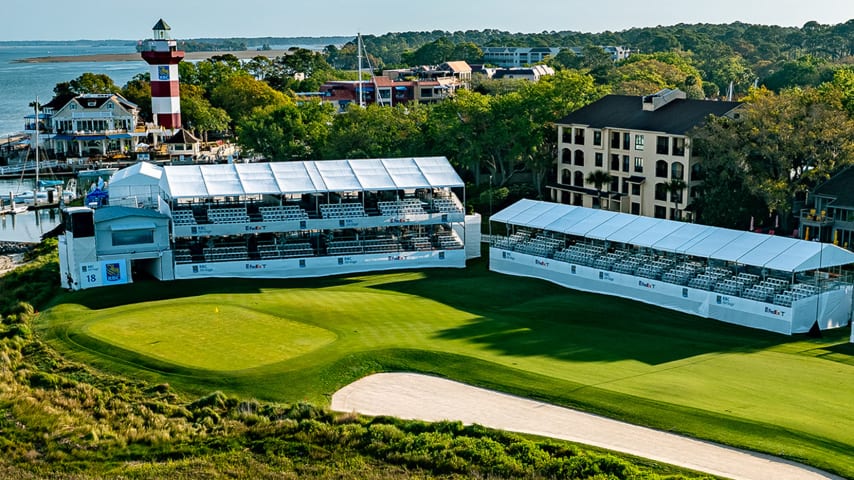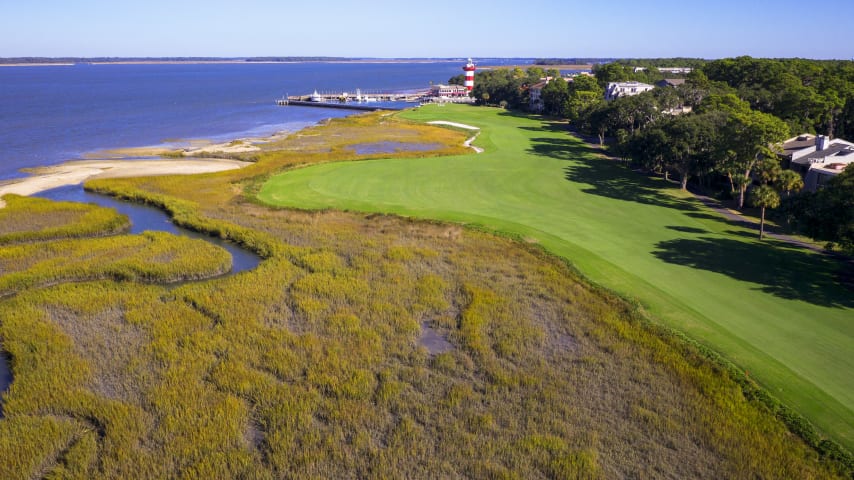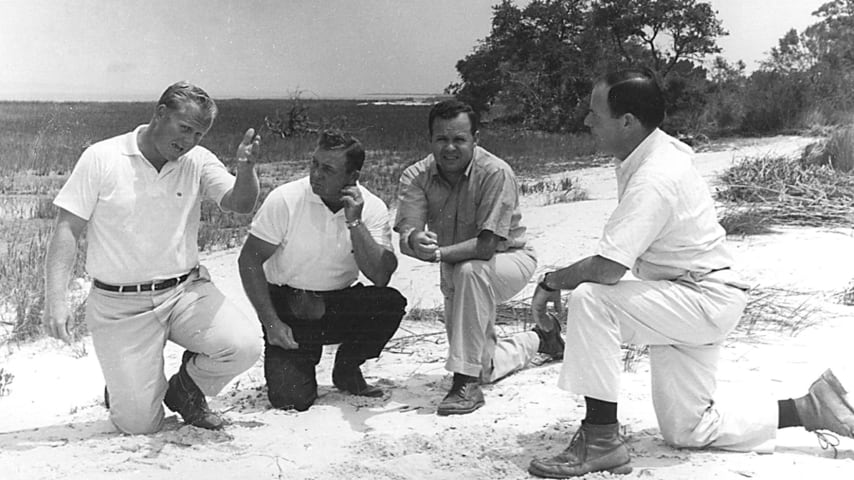Harbour Town a watershed design in architecture history
9 Min Read

Rarely in the history of golf does the opening of a course serve as a turning point in the game’s history. But that is precisely what happened with the debut of Harbour Town Golf Links in Hilton Head Island, South Carolina, during Thanksgiving week in 1969.
Its introduction to the golf world occurred when it hosted the inaugural RBC Heritage. The fact that the tournament ended a 14-month winless drought for arguably the most popular player in the game’s history, Arnold Palmer, only increased the attention given to this new course on the Calibogue Sound. As did the unusual nature of the golf course – short, tight and demanding precise shotmaking to targets sculpted out of flat ground and carved through overhanging corridors of live oaks. Harbour Town Golf Links was totally unlike the other courses on the pro circuit and conveyed the fresh vision of two master craftsman.
The layout was a collaboration between Pete Dye and Jack Nicklaus and effectively launched – or consolidated - their respective design credentials. And for the sleepy island of Hilton Head, the course marked a transition from quiet Intracoastal outpost to a full-fledged powerhouse of a golf destination.

In this emerald-hued finale, the famous lighthouse becomes a beacon to landlubbers. A successful shot is one aimed toward the cherished landmark. The goal is the wide landing area jutting into Calibogue Sound. A word of advice on one of golf's most spectacular finishing holes: the long approach to the flag offers ample bailout to the right where the innocent-looking but insidious mounding has caused many want-to-be champs to lose a sought-after par.
At the time, Dye was still an aspiring designer who had only recently shed his day job as an insurance salesmen to dive headlong into his new career. He had started to make his mark in the Midwest, working out of his home office just north of Indianapolis. From there, working with his wife Alice, a champion golfer and a student of turfgrass and design, the Dyes had developed a strong regional reputation by designing Radrick Farms in Ann Arbor, Michigan; Crooked Stick in Carmel, Indiana; and The Golf Club in New Albany, Ohio.
By then, Nicklaus was halfway through completing his second career Grand Slam and had established himself as the dominant golfer of his day. He devoted a chapter to course architecture in his 1969 memoir, “The Greatest Game of All,” where he expressed a preference for strategic golf over penal design, favored visibility of approach shots into greens, and mused about the development of cast mounding behind greens so that spectators and TV cameras could better follow the action.
The relationship between Dye and Nicklaus dates to Nicklaus’ amateur days. They both played in the 1957 U.S. Open at the Inverness Club in Toledo, Ohio. A year later, the two met in the semifinals of the Trans-Mississippi Amateur at Prairie Dunes Country Club in Hutchinson, Kansas. The 18-year-old Nicklaus outdrove Dye, 32, by 30 yards and won, 3 and 2. Nicklaus won the event a day later, his first amateur victory of national repute. Dye was fond of saying later that, “If I had beaten him then it would have changed the history of golf.”

From left to right, Jack Nicklaus, Donald O’Quinn, Charles Fraser, Pete Dye prior to the construction of Harbour Town Golf Links. (Credit the Heritage Classic Foundation)
By the mid-1960s, Nicklaus had started searching around his native Columbus, Ohio, for property suitable for what would eventually become Muirfield Village Golf Club, the site of his annual Memorial Tournament presented by Workday. In 1965, he heard about the development of a private golf retreat on the far northeast side of town. That’s where Dye was creating The Golf Club. Dye had Nicklaus out for a few early tours of the course. At one visit, Nicklaus came to the par-3 third hole, which played across a pond to a circular green surrounded by symmetrically arrayed rocks and wood planking. Dye asked the great golfer what he thought. “Pete,” Jack said in his squeaky voice, “that’s the ugliest hole I’ve ever seen in my life.” Dye changed the hole, and the result is one of his most iconic par-3s.
Meanwhile, over on the Intracoastal barrier island of Hilton Head Island, South Carolina, the real estate developer and promoter Charles Fraser was involved in a resort on the far southern tip of the 69-square-mile landmass. Having convinced the state in 1956 to build a two-lane bridge from the Bluffton side of the Lowcountry mainland to the island, Fraser went about developing a 5,000-acre parcel into Sea Pines Plantation.
As a whimsical landmark for the property, Fraser also erected a lighthouse – the first one built along the East Coast in 70 years. The red and white banded, nine-story lighthouse along Calibogue Sound became known as “Fraser’s Folly.” But the overall achievement was nothing to be laughed at because it put the entire island on the world’s map as a destination.

The island’s first two courses were George Cobb designs – Sea Marsh in 1961 and the Ocean Course in 1967. But the island did not become a golf hotbed until the creation of Harbour Town Golf Links. Fraser, who was not himself a golfer, knew enough about marketing to call upon Nicklaus, who in turn recommended Dye for the job. Dye agreed - his first commission outside the Midwest. Nicklaus, who was still playing the PGA TOUR full-time, signed on in a consulting role for his first paid design work.
With his design of Harbour Town, Dye seemed intent to do the exact opposite of what Robert Trent Jones Sr., the pre-eminent architect of the day who was nicknamed “The Open Doctor” for his hand in preparing several venues for that championship. The result at Harbour Town was a ground-hugging layout with small tees, fairways that curved steadily instead of doglegging, and very tiny greens with subtle fall-offs and room for run-up shots as well.
Cobb did an early routing, and Dye stuck with it through the first 16 holes. But at the finish, where Cobb’s holes stayed inland, Dye veered sharply left out to the water for a dramatic coastal finish. The result would be among the PGA TOUR’s most scenic finishing stretches.
The land upon which the course sat offered only 4 feet of elevation change across the entire site. There are putting surfaces and green surrounds at Augusta National with more movement than that. Dye’s work sat the golf shots down, snaking them through the live oaks and pines that had been there for decades.
He accentuated the intimate scale with many small bunkers, some of them so minuscule – like the one behind the green on the par-3 14th - that they formed little pots with barely enough room for a player to swing a club. Against these he juxtaposed the occasional long, flowing sand splashes, including a massive one inside the dogleg of the par-4 16th that was made from construction material – sand, crushed coquina shells and excavated soil. The hazard became known as a “waste bunker,” the first time that term was used in American golf design.
Typical of Dye, he wasn’t just using the land – in some cases he was creating it. That’s how the 18th fairway acquired its unusual shape. Dye and the construction team created that fairway from fill dredged from the harbor.
How much involvement Nicklaus had on the course is to this day a matter of speculation. The scorecard lists him as “design consultant” and credits Dye as the course’s architect. Nicklaus said in 2004 that he registered 21 trips to the site on his twin-engine, turbo-prop plane. “Yeah,” said Dye, “but for most of those I was borrowing your plane while you were playing on TOUR.”
The friends collaborated on another half-dozen design projects before Nicklaus formed his own design firm in 1973.
Dye, for his part, went on to a Hall of Fame design career that included such tournament venues as THE PLAYERS Stadium Course at TPC Sawgrass in Ponte Vedra Beach, Florida; PGA West’s Stadium Course in La Quinta, California; the Ocean Course at Kiawah Island Resort in South Carolina; and Whistling Straits’ Straits Course in Mosel, Wisconsin.
Harbour Town Golf Links was immediately lauded for its ingenious shot-making demands, Attention focused on its set of par-3s, often referred to as one of the most engaging sets of one-shot holes of any major golf course. In part, their arrangement in different directions ensured that players would face wind from a variety of directions. Even today, with Harbour Town’s par-3s all measuring between 190 and 200 yards, there can be as much as three- or four-club variance from one hole to the next as players confront the wind.
As late as 1995, Harbour Town played to only 6,657 yards and a par-71. It was the shortest venue on the PGA TOUR, yet one that held up because of the intimacy of its routing and the way in which the angles into green required more emphasis upon proper position off the tee than sheer length. It has been subsequently stretched to 7,191 yards, an 8% increase that only partially compensates for the 13% increase in driving distance over that time.
The genius of Harbour Town is in the ground game. It is the ultimate in ‘small ball” venue. At the 588-yard, par-5 15th, the green is perched around a kind of “peek-a-boo” corner formed by trees, sand and the axis of the green. It’s a small target for those trying to reach the green in two, so it remains a three-shot hole.
Even more characteristic of Harbour Town, and of Dye’s genius, is the short par-4 13th, which measures just 373 yards. The target looks positively medieval – a green surrounded by a moat of sand and surrounded by the sharp edges of railroad ties. It is the ultimate in precision golf. It’s also a hole whose aesthetic character owes a lot to the insight of Alice Dye; she rescued the hole from Pete’s rough, early version. In that sense, Harbour Town is yet another watershed – the influence of a woman designer is unmistakable.
Harbour Town opened the floodgates. Beach-going resort goers started coming here in droves for the golf as well as the sun. Homes started popping up along the length of the island and now there are more than 350 golf courses in the state of South Carolina. Design work flooded the offices of Dye and Nicklaus. And golf architecture came to embrace the virtues of intimacy, angles, position and shot-making.
That’s quite an achievement for a golf course. It’s why the RBC Heritage and Harbour Town remain fascinating more than a half-century after they began life.
Bradley S. Klein is a veteran golf writer and author of 10 books on course design. A former PGA TOUR caddie, he was architecture editor of Golfweek for over two decades and is now a freelance journalist and course design consultant. Follow Bradley S. Klein on Twitter.





